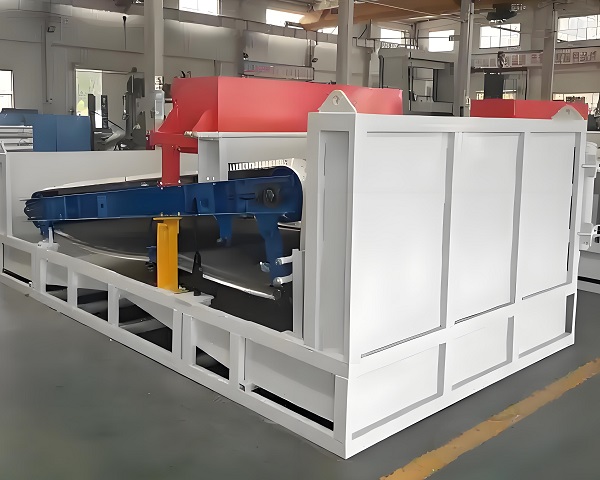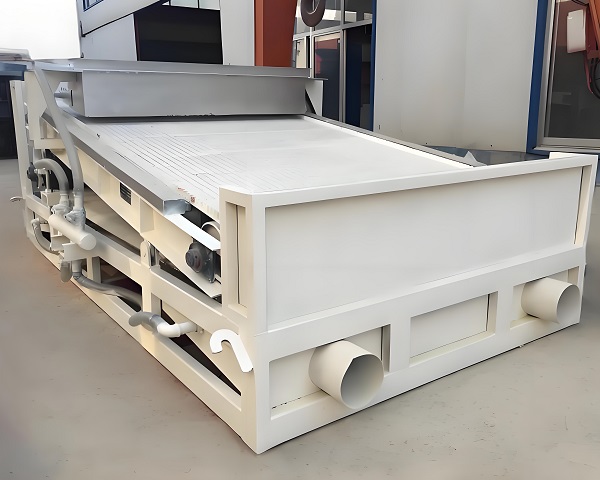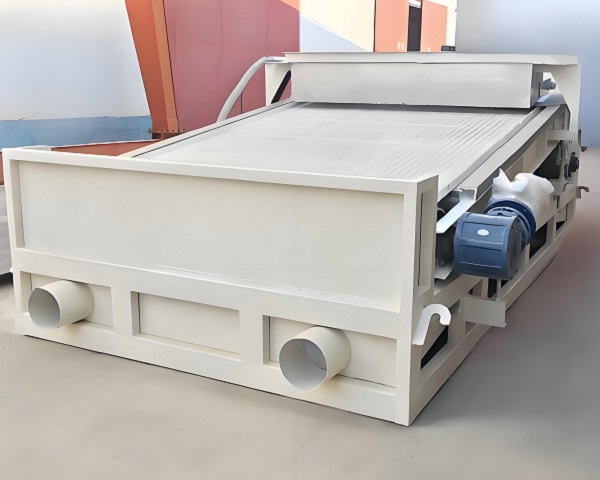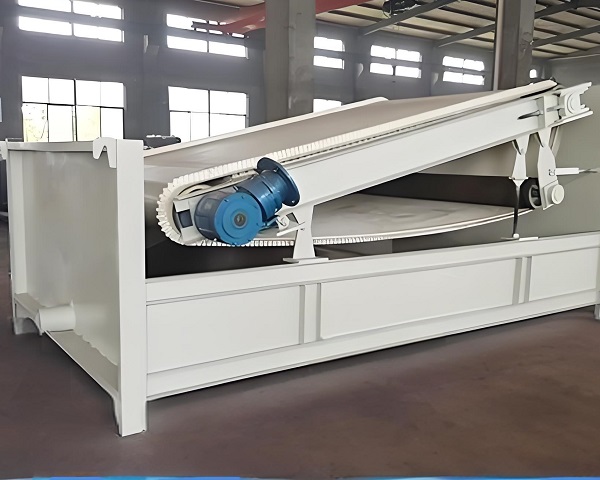A Trommel Screen is a rotary drum screening machine widely used in waste processing, mining, and construction industries. It efficiently separates materials by ......
What is the Magnetic Separator for Sale
Magnetic separator is a mechanical equipment that separates materials based on the magnetic difference of materials. It is widely used in the fields of mineral resource development, industrial waste treatment, environmental protection, etc. Its core working principle is that when materials containing magnetic substances pass through the magnetic field area of the magnetic separator, the magnetic particles will be adsorbed to the cylinder, disc or other magnetic separation components of the magnetic separator under the action of magnetic force, and will be taken to a specific position for discharge as the components move; while non-magnetic materials are not affected by magnetic force and are discharged from the other side under the action of gravity, centrifugal force, etc., thereby achieving the separation of magnetic and non-magnetic materials.
According to the magnetic field generation method, equipment structure and application scenarios, magnetic separators can be divided into many types. According to the magnetic field generation method, there are permanent magnetic separators and electromagnetic magnetic separators. Permanent magnetic separators use permanent magnets to provide magnetic fields, which have the advantages of low energy consumption and simple maintenance. They are often used to process ores with strong magnetism; electromagnetic magnetic separators generate magnetic fields by energizing electromagnetic coils, and the magnetic field strength can be adjusted, which is suitable for the separation of materials with weaker magnetism. From the structural point of view, common ones are cylindrical magnetic separators, disc magnetic separators and belt magnetic separators. The drum magnetic separator is the most commonly used type. The material is sorted when it passes through the surface of the drum, which is suitable for continuous operation; the disc magnetic separator uses multiple rotating discs to perform multiple sorting to improve the sorting accuracy; the belt magnetic separator uses a conveyor belt to transport materials, which is suitable for processing powdered or small-particle materials.
In practical applications, magnetic separators play an irreplaceable role. In the mining field, it is the core equipment for iron ore sorting, which can effectively extract iron concentrate from lean ore and improve the ore grade; in the beneficiation process of non-ferrous metal mines, it can also be used to remove associated magnetic impurities. In the environmental protection industry, magnetic separators can recover magnetic metals such as scrap steel and iron filings from industrial waste and urban garbage to achieve resource recycling; in sewage treatment, by adding magnetic flocculants, magnetic separators can also efficiently separate suspended matter and pollutants in sewage.
The advantages of magnetic separators are significant. It has the characteristics of high sorting efficiency and large processing capacity, can realize automatic continuous operation, and reduce labor costs; it is environmentally friendly and does not produce a large amount of wastewater and waste residue; and it can flexibly adjust equipment parameters and working modes according to different material characteristics and sorting requirements. With the continuous advancement of technology, the new magnetic separator continues to improve in magnetic field strength, sorting accuracy and intelligence, and will play a greater role in more fields in the future.
Operating principle of Magnetic Separator for Sale
Magnetic separators are equipment that separates different minerals based on their magnetic properties. They are widely used in mining, environmental protection, chemical industry and other fields. The core working principle is to use magnetic field force to attract or repel magnetic minerals and separate magnetic from non-magnetic minerals.
The working process of magnetic separators is mainly divided into three stages: First, the magnetic field is generated. Depending on the type of equipment, the magnetic field is provided by a permanent magnet or an electromagnetic coil. Permanent magnetic separators use high-performance permanent magnetic materials (such as neodymium iron boron) to form a stable magnetic field, with a simple structure and low energy consumption; electromagnetic magnetic separators generate magnetic fields by passing current through coils, and the magnetic field strength can be flexibly controlled by adjusting the current. Secondly, when the material to be selected enters the magnetic field area, magnetic minerals (such as magnetite and pyrrhotite) will be attracted by the magnetic field and adsorbed on the cylinder surface of the magnetic separator or the sorting medium; non-magnetic minerals (such as quartz and feldspar) are not affected by magnetic field forces and are discharged from other channels under the action of gravity, water flow or centrifugal force. Finally, the adsorbed magnetic minerals rotate with the cylinder or separation medium to the area with weak magnetic field, and are separated from the surface of the equipment by unloading devices (such as flushing water and scrapers) to complete the collection of magnetic minerals.
The key components of the magnetic separator have a significant impact on the sorting effect. Taking the cylindrical magnetic separator as an example, the magnetic field distribution on the surface of the cylinder determines the adsorption capacity and separation efficiency of the minerals. Reasonable magnetic field gradient design can ensure that the magnetic minerals are quickly adsorbed and not easy to fall off. The sorting medium (such as steel wool and magnetic concentrator in the magnetic separation tube) can enhance the local magnetic field strength in the high-gradient magnetic separator and capture smaller weak magnetic minerals. In addition, the feeding system needs to ensure that the material is evenly dispersed into the magnetic field area to avoid affecting the sorting accuracy due to material accumulation; the discharge system needs to discharge the separated minerals in a timely and clean manner to prevent secondary mixing.
There are subtle differences in the working principles of different types of magnetic separators. Weak magnetic field separators are suitable for the separation of strongly magnetic minerals, and can achieve efficient separation with a relatively low magnetic field strength; strong magnetic field separators use high-intensity magnetic fields to produce induced magnetism to complete the separation of weakly magnetic minerals such as hematite and limonite; superconducting magnetic separators use the characteristic of superconducting materials with zero resistance at extremely low temperatures to generate ultra-strong magnetic fields, which can process minerals with extremely weak magnetism and extremely fine particle sizes, and the energy consumption is greatly reduced compared to traditional electromagnetic magnetic separators.
In practical applications, magnetic separators are often used in conjunction with other mineral processing equipment (such as crushers, ball mills, and flotation machines) to form a complete mineral processing process. By reasonably adjusting the magnetic field strength, sorting speed, feed concentration and other parameters of the magnetic separator, the best sorting effect can be achieved according to different mineral characteristics and production needs, and the mineral recovery rate and concentrate grade can be improved.
Advantages and features of Magnetic Separator for Sale
Magnetic separators are equipment that achieves efficient separation based on the magnetic difference of materials. They play an irreplaceable role in mineral development, resource recovery, environmental protection and other fields. Their unique characteristics and significant advantages have promoted technological innovation and production efficiency improvement in many industries.
The core advantage of magnetic separators lies in their extremely high separation accuracy. It generates strong suction on magnetic materials through a strong magnetic field, can accurately adsorb and separate magnetic minerals such as iron and manganese, and can even capture fine magnetic particles. In iron ore beneficiation, magnetic separators can efficiently enrich raw ore with low iron content, greatly improve the grade of concentrate, and effectively reduce subsequent smelting costs and energy consumption. Compared with other separation methods, magnetic separators use the essential characteristics of magnetism, and the separation process is not affected by the color, shape, and density of the material, achieving highly accurate sorting.
The strong adaptability of the equipment is also a highlight. There are various types of magnetic separators, including permanent magnetic separators, electromagnetic magnetic separators, etc., which can be flexibly selected according to different working conditions. Permanent magnetic separators do not require additional power supply, have a simple structure and stable operation, and are suitable for scenarios with large processing volume and cost sensitivity; the electromagnetic magnetic separator has an adjustable magnetic field strength, which can meet the needs of complex materials and high-precision separation. In addition, the magnetic separator has a wide range of adaptability to material particle sizes, from coarse-grained ore to fine-grained ore mud, which can be effectively separated and can play a role in many fields such as mining, environmental protection, and chemical industry.
The magnetic separator also has the dual advantages of green environmental protection and economy. Its separation process does not require the addition of a large amount of chemical agents, which avoids environmental pollution and conforms to the concept of sustainable development. Moreover, during the operation of the magnetic separator, the mechanical structure is relatively simple and the failure rate is low. Daily maintenance only requires regular inspection of the magnetic field strength and cleaning of adsorbed magnetic materials, which reduces maintenance costs. At the same time, the efficient separation capacity greatly improves the resource recovery rate and creates higher economic benefits for the enterprise.
The magnetic separator is easy to realize automatic control. Through the integrated sensor and intelligent control system, the magnetic field strength, material flow and separation effect can be monitored in real time, and the equipment operation parameters can be automatically adjusted to ensure a stable and efficient separation process. This automated feature not only reduces manual operation errors, but also improves production efficiency, reduces labor costs, and makes the magnetic separator more competitive in large-scale industrial production.
Technical Parameter Table of Magnetic Separator for Sale
| Model | Magnetic Field Strength (mT) | Drum Diameter (mm) | Drum Length (mm) | Capacity (TPH) | Motor Power (kW) | Type | Application Material |
|---|---|---|---|---|---|---|---|
| MS-600 | 120 | 600 | 800 | 10–20 | 1.5 | Dry Drum | Sand / Iron Ore |
| MS-750 | 150 | 750 | 1000 | 20–40 | 2.2 | Wet Drum | Slurry / Hematite |
| MS-900 | 180 | 900 | 1200 | 30–50 | 3.0 | Dry Belt | Recycled Metal / Slag |
| MS-1100 | 200 | 1100 | 1500 | 50–70 | 4.0 | Wet Drum (Counter Flow) | Magnetite / Iron Sand |
| MS-1300 | 220 | 1300 | 1800 | 70–100 | 5.5 | High Intensity Roller | Non-metallic impurities |
| MS-1500HD | 300 | 1500 | 2000 | 100–150 | 7.5 | Electromagnetic | Strong Magnetic Separation |
If you have any special requirements, we will customize according to your special needs.
Product Picture Display of Magnetic Separator for Sale
FAQ about Magnetic Separator for Sale
>How to choose a suitable Magnetic Separator?
Material properties (magnetic strength, particle size, humidity), processing capacity, separation accuracy and budget should be considered comprehensively. For materials with weak magnetism, high field strength equipment should be selected; for materials with large processing capacity, large equipment should be selected; for materials with high separation accuracy requirements, multi-stage magnetic separation or superconducting magnetic separators can be selected; at the same time, the energy consumption and maintenance cost of the equipment should be considered.
>How does the magnetic field strength of the Magnetic Separator affect the separation effect?
The magnetic field strength directly determines the attraction to magnetic materials. The higher the strength, the stronger the adsorption capacity for weak magnetic or fine magnetic particles, and the higher the separation accuracy, but too high a magnetic field strength may adsorb too many impurities and affect the separation purity, which needs to be reasonably adjusted according to the material characteristics.
>What are the precautions for installing a Magnetic Separator?
During installation, ensure that the equipment is placed horizontally to avoid uneven magnetic field distribution; when connecting the power supply, pay attention to the voltage and equipment adaptation, and do a good job of grounding protection; the feed inlet and the discharge port need to be reasonably laid out to ensure smooth material flow; reserve enough maintenance space for subsequent maintenance.
>What does daily maintenance of a Magnetic Separator include?
Daily maintenance requires regular cleaning of materials adsorbed on magnetic components to prevent accumulation from affecting the separation effect; check the wear of the transmission components of the equipment (such as belts and chains) and replace them in time; monitor whether the magnetic field strength is stable. If there is attenuation, check the magnet or circuit; for electromagnetic separators, pay attention to the coil temperature to avoid overheating.
>How to troubleshoot Magnetic Separator failure?
If the separation effect decreases, check whether the magnetic field strength is normal and whether the material feeding is uniform; if the equipment vibrates abnormally, check whether the foundation is stable and whether the transmission components are loose; if the electromagnetic separator does not generate a magnetic field, it may be a power failure or coil damage, and the circuit and coil need to be checked.
>Can the Magnetic Separator handle wet materials?
It can handle wet materials. Some magnetic separators are designed with waterproof structures and can adapt to wet environments. However, overly wet materials may cause magnetic particles to agglomerate and affect the adsorption effect. If necessary, the material can be pre-treated, or a magnetic separator with a cleaning device can be selected.
>Is the energy consumption of the Magnetic Separator high?
Energy consumption varies by type. Permanent magnetic separators do not require additional electricity to maintain the magnetic field, and have low energy consumption; electromagnetic magnetic separators consume electricity to generate magnetic fields, and have relatively high energy consumption, but through optimized design and intelligent control, operating costs can be reduced; although superconducting magnetic separators have strong magnetic fields, the low-temperature maintenance system will increase energy consumption.
>What is the service life of a magnetic separator?
Under normal use and maintenance, the service life of a permanent magnetic separator can reach more than 10 years; the coil and electronic components of an electromagnetic magnetic separator have a relatively short life of about 5-8 years; the actual life of the equipment is affected by factors such as material properties, frequency of use, and maintenance, and may be shortened under harsh working conditions.
>Can a magnetic separator be customized?
Yes. Manufacturers can customize equipment size, magnetic field strength, structural form, and degree of automation based on customer material properties, processing volume, site conditions, and other requirements. For example, for special magnetic materials, design a dedicated magnetic field distribution; for high processing volume requirements, increase equipment specifications.
>What are the advantages of a magnetic separator compared to other separation equipment?
Compared with traditional screening and flotation equipment, magnetic separators have higher separation efficiency and better precision for magnetic materials, and the separation process does not require the addition of chemical agents, which is more environmentally friendly; for materials containing magnetic impurities, magnetic separators can achieve rapid separation, simplify the process flow, and reduce costs.
>What are the safety precautions for operating Magnetic Separator?
When operating, stay away from strong magnetic field areas and avoid bringing magnetic objects close to the equipment; do not put your hands or other objects into the working area when the equipment is running; check the grounding of the equipment regularly to prevent leakage; when cleaning magnetic parts, you must first turn off the power and take protective measures to prevent the adsorbed materials from splashing and injuring people.
>What types of Magnetic Separator are there?
The main types are permanent magnetic separators, which use permanent magnets to generate magnetic fields, with simple structures and low energy consumption; electromagnetic magnetic separators, which generate magnetic fields through currents, with adjustable magnetic field strength, suitable for complex working conditions; superconducting magnetic separators, which use superconducting materials to generate strong magnetic fields, have high separation efficiency, and are mostly used in fine separation scenarios.
>What are the main applications of Magnetic Separator?
In the mining industry, it is used for the beneficiation and purification of metal ores such as iron ore and manganese ore; in the environmental protection field, it is used to treat industrial wastewater and urban sewage and separate magnetic pollutants; in the food industry, it is used to remove magnetic impurities in raw materials to ensure food safety; it is also used in industries such as electronic waste recycling and glass manufacturing.

































